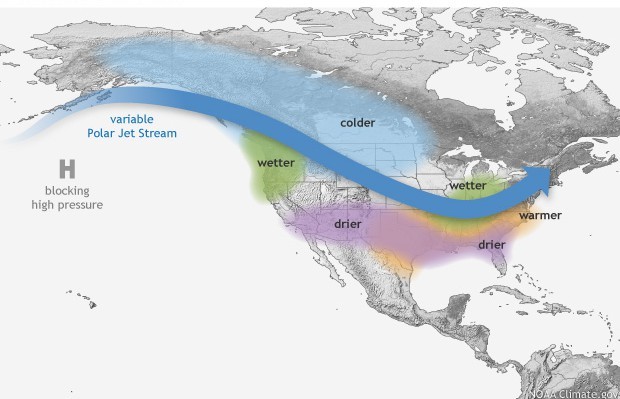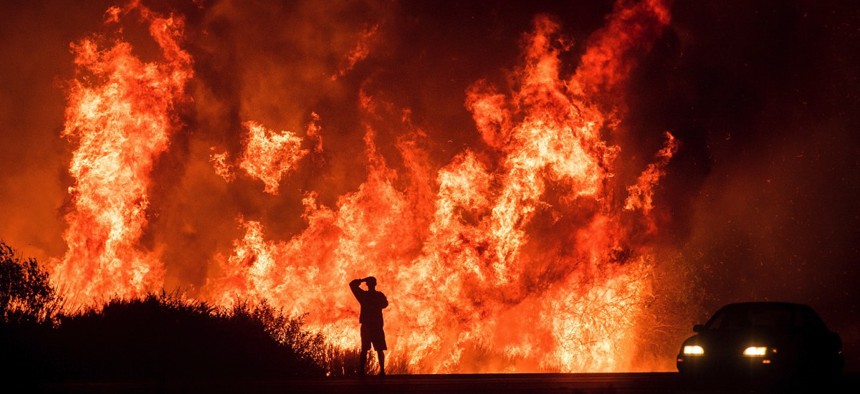Connecting state and local government leaders
Seven of the state’s 10 largest modern wildfires have occurred in the last 14 years.
Massive wildfires are raging across Southern California, threatening thousands of homes and cultural landmarks like the Getty Museum in Los Angeles. Some of the largest fires were still barely contained by Wednesday afternoon.
It’s been an unusually bad year for the state—amid an unusually bad year for the West at large. Fires in California have destroyed more than 6,000 structures and incinerated hundreds of thousands of acres. Montana and British Columbia both also had some of their worst wildfire seasons ever.
Of course, most years are bad wildfire years now. Seven of California’s 10 largest modern wildfires have occurred in the last 14 years. (The state began keeping reliable records in 1932.) Given the scale of the blazes, and their increasing regularity, it makes sense to ask: Does global warming have anything to do with this?
The answer isn’t as clear-cut as it was this summer, when drought- and heat-stoked fires raged across the Rockies and Pacific Northwest. Instead, a mix of forces are driving the fires in Southern California, and only some of them have a clear connection to global warming.
“These fires are not immediately emblematic of climate change,” said John Abatzoglou, an associate professor of geography and climate at the University of Idaho, in an email. “Yes, California did have the warmest summer on record. But the big anomaly here is the delay in the onset of precipitation for the southland that has kept the vegetation dry and fire-prone.”
In other words, late-fall and winter rains would normally end California’s fire season in November. Because those rains haven’t yet arrived, the blazes continue.
“At least in Southern California right now, we are largely seeing textbook wildfires,” said Alexandra Syphard, a senior research scientist at the Conservation Biology Institute who studies fires. “Wind-driven fire events occur most typically in the fall, but can also occur like this, later in the year with fast-spreading, ember-driven fires under Santa Ana wind conditions.”
Here are some of the biggest factors that are shaping the wildfires in California—and how global warming is or isn’t changing them:
The Santa Ana Winds
Blame for the wildfires in Ventura and Los Angeles counties lies first and foremost with the Santa Ana winds, famously hot and desiccating gusts that blow from the desert to the coast. The Santa Anas also set the stage for the massive wildfires in Napa and Sonoma earlier this year.
Fires depend on two variables—an ignition source and fuel to burn—and the Santa Ana winds increase the availability of both. First, they dry out vegetation, creating more fuel across the landscape. Second, they blow trees and other debris against power lines, providing the source of a spark.
When the Santa Anas blow this late in the year, they can start fires. In fact, writes Abatzoglou, “all December fires in the southland since 1948 have been associated with Santa Ana wind.”
But there are few signs—at least so far—that the Santa Ana winds are becoming more prevalent or that they’re systematically moving later in the year. The peak of Santa Ana season usually comes in September or October. There is no trend toward more or fewer Santa Ana fires—or Santa Ana winds generally—in the historical record, Abatzoglou told me.
A 2006 study from researchers at the University of California and Berkeley National Labs suggested that by the end of the century, Santa Ana winds may become more common. They may also form later in the year, including in December.
La Niña
There’s currently a weak La Niña in the tropical Pacific, which means that global temperatures are cooler than they would be otherwise.
The same phenomenon is also keeping storms from making landfall in Southern California. Normally, California’s wet season would have started by this time of year. “Once [autumn] rains hit the region, fuel moistures recover and make the landscape fire-resistant, thus reducing the odds that a power-line failure or vehicle will start a fire,” said Abatzoglou.
But the rains haven’t yet appeared, he told me. “So far this autumn, much of the southern half of California is pitching a shutout in terms of rainfall to date. Some of this is characteristic of La Niña ... as the southern tier of the United States sees less precipitation during La Niña winters.”
La Niña raises the polar jet stream, making the southwestern United States drier than it would be otherwise. (NOAA)

It’s still unclear how climate change will affect the Pacific’s yearly dance between El Niño, La Niña, and a neutral state. A 2015 study in Nature Climate Change found that the Pacific Ocean may careen between extreme states—from an intense El Niño to a monster La Niña—by the end of the century, but more research on the question still needs to be done.
A Very Cold U.S. East Coast
Even as the West Coast remains warm and dry, the Eastern Seaboard is settling into some of its first cold weather of the season. This pattern—a warm West, a frigid East—is known as the North American winter dipole.
It’s caused when the jet stream—which both ferries storms into the continent and generally divides warm air from cold air—gets especially twisted across North America. It rises far into the Canadian Northwest, keeping most of the western United States warm and dry; then it cascades down across the middle of the country, bringing cold air well into the U.S. Southeast.
This phenomenon prolonged California’s drought during the first part of this decade, keeping any kind of storm system offshore. It also brought the infamous “polar vortex” down into the continental United States.
There are a number of theories about how this pattern comes to form, and most of them revolve around climate change, as Jason Samenow writes at The Washington Post.
Daniel Swain, a climate scientist at the University of California, Los Angeles, argues that the ridge forms in part because the West is warming up much faster than the East. If this is the case, then scientists might expect to see the phenomenon fade in decades to come, as the East Coast catches up to the West.
But a paper published this week in Nature Communications takes another view. It finds that the disappearance of sea ice over the Arctic Ocean could change the circulation of the Pacific Ocean, encouraging the jet stream to veer north. In other words, climate change will make something like the North American winter dipole keep reappearing.
Robinson Meyer is an associate editor at The Atlantic, where this article was originally published.

NEXT STORY: Emergency CHIP Funds for States Are Nearly Halfway Gone




